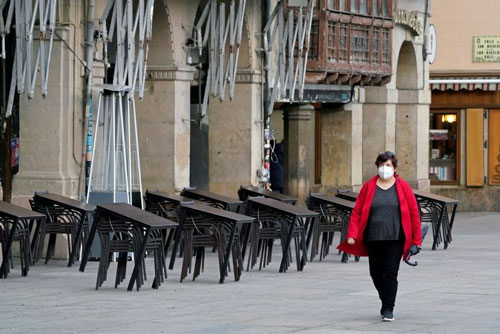Madrid
Spanish Prime Minister Pedro Sanchez announced a new state of emergency on Sunday in an effort to curb soaring coronavirus infections, imposing local nightime curfews and banning travel between regions in certain cases.
“We are living in an extreme situation…it is the most serious in the last half century,” he told a news conference following a cabinet meeting.
The measure goes into force from Sunday night and will require all regions except the Canary Islands to impose a nighttime curfew.
The state of emergency will need parliamentary approval to last beyond 15 days. Sanchez asked for parliament to approve its extension up to May 9.
A growing number of regions had been calling on the government to implement the measure. Spain imposed one of the toughest lockdowns early on in the pandemic and then relaxed curbs over the summer.
But like many other European countries it has seen a second wave hit in recent weeks, and now has one of the highest numbers of infections in Western Europe. Total cases rose to 1,046,132 on Friday, while the death toll is nearing 35,000.
The decree will serve as a legal framework to implement a new warning system of levels, similar to the ones already applied in countries such as Germany and France.
According to the level of risk, travelling between regions could be banned if a regions decides, except for justified reasons such as working. Movement could also be restricted within regions in localised lockdowns.
Most of the regions are already above the parameters to be considered at the highest level of risk.
Asia surpassed 10 million infections of the new coronavirus on Saturday, the second-heaviest regional toll in the world, according to a Reuters tally, as cases continue to mount in India despite a slowdown and sharp declines elsewhere.
Behind only Latin America, Asia accounts for about one-fourth of the global caseload of 42.1 million of the virus. With over 163,000 deaths, the region accounts for some 14% of the global Covid -19 toll.
The Reuters tally is based on official reporting by countries. The true numbers of cases and deaths are likely much higher, experts say, given deficiencies in testing and potential underreporting in many countries.
Despite the Asian spikes, the region overall has reported improvement in handling the pandemic in recent weeks, with daily caseloads slowing in places like India – a sharp contrast to the Covid-19 resurgence seen in Europe and North America.
Within the region, South Asia led by India is the worst affected, with nearly 21% of the reported global coronavirus cases and 12% of deaths. This contrasts with countries like China and New Zealand that have crushed infections and Japan, where Covid -19 had been stubbornly entrenched but not accelerating.
India is the worst-hit country in the world after the United States, although infections are slowing in the world’s second-most populous country. India is reporting more than 57,000 cases of the virus a day, viewed on a weekly average, with 58 new cases per 10,000 people in Asia’s third-largest economy, according to a Reuters analysis.
India is averaging 764 Covid -19 deaths a day, the worst in the world and accounting for one in every 13 global pandemic deaths.
The country has reported nearly 7.8 million infections, behind the U.S. tally of 8.5 million, and nearly 118,000 deaths, versus 224,128 in the United States. Unlike the recent U.S. surge, however, India’s slowdown saw the lowest daily caseload in nearly three months on Wednesday.
But India’s infections may surge again, doctors fear, with a holiday approaching and winter bringing more severe pollution from farmers burning stubble, worsening the breathing difficulties that many Covid -19 patients suffer.
India’s eastern neighbour Bangladesh is Asia’s second-worst hit country, with nearly 400,000 cases. But daily infections have slowed to 1,453, less than 40% of the July peak.—AFP









